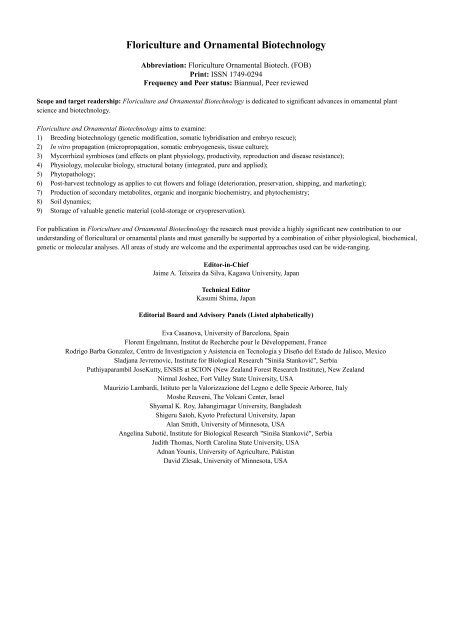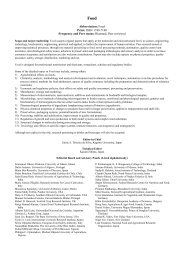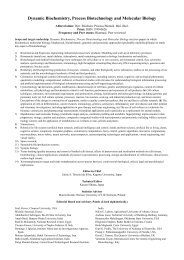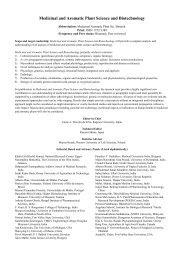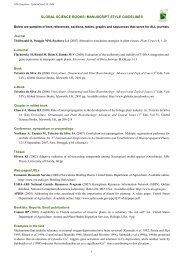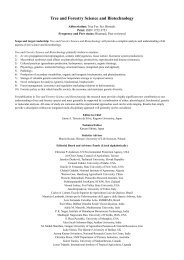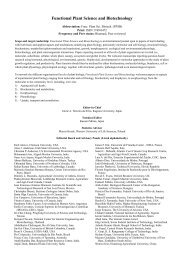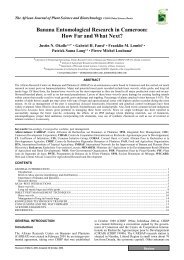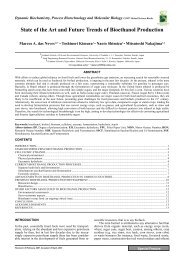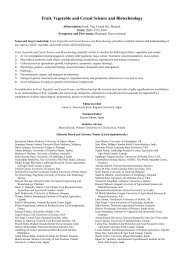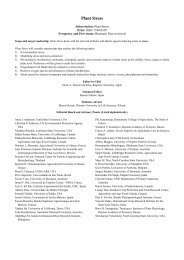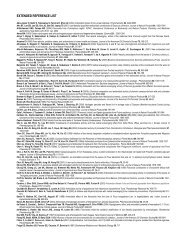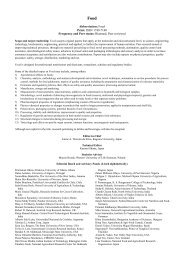Issue infomation - Global Science Books
Issue infomation - Global Science Books
Issue infomation - Global Science Books
Create successful ePaper yourself
Turn your PDF publications into a flip-book with our unique Google optimized e-Paper software.
Floriculture and Ornamental Biotechnology<br />
Abbreviation: Floriculture Ornamental Biotech. (FOB)<br />
Print: ISSN 1749-0294<br />
Frequency and Peer status: Biannual, Peer reviewed<br />
Scope and target readership: Floriculture and Ornamental Biotechnology is dedicated to significant advances in ornamental plant<br />
science and biotechnology.<br />
Floriculture and Ornamental Biotechnology aims to examine:<br />
1) Breeding biotechnology (genetic modification, somatic hybridisation and embryo rescue);<br />
2) In vitro propagation (micropropagation, somatic embryogenesis, tissue culture);<br />
3) Mycorrhizal symbioses (and effects on plant physiology, productivity, reproduction and disease resistance);<br />
4) Physiology, molecular biology, structural botany (integrated, pure and applied);<br />
5) Phytopathology;<br />
6) Post-harvest technology as applies to cut flowers and foliage (deterioration, preservation, shipping, and marketing);<br />
7) Production of secondary metabolites, organic and inorganic biochemistry, and phytochemistry;<br />
8) Soil dynamics;<br />
9) Storage of valuable genetic material (cold-storage or cryopreservation).<br />
For publication in Floriculture and Ornamental Biotechnology the research must provide a highly significant new contribution to our<br />
understanding of floricultural or ornamental plants and must generally be supported by a combination of either physiological, biochemical,<br />
genetic or molecular analyses. All areas of study are welcome and the experimental approaches used can be wide-ranging.<br />
Editor-in-Chief<br />
Jaime A. Teixeira da Silva, Kagawa University, Japan<br />
Technical Editor<br />
Kasumi Shima, Japan<br />
Editorial Board and Advisory Panels (Listed alphabetically)<br />
Eva Casanova, University of Barcelona, Spain<br />
Florent Engelmann, Institut de Recherche pour le Développement, France<br />
Rodrigo Barba Gonzalez, Centro de Investigacion y Asistencia en Tecnologia y Diseño del Estado de Jalisco, Mexico<br />
Sladjana Jevremovic, Institute for Biological Research "Siniša Stanković", Serbia<br />
Puthiyaparambil JoseKutty, ENSIS at SCION (New Zealand Forest Research Institute), New Zealand<br />
Nirmal Joshee, Fort Valley State University, USA<br />
Maurizio Lambardi, Istituto per la Valorizzazione del Legno e delle Specie Arboree, Italy<br />
Moshe Reuveni, The Volcani Center, Israel<br />
Shyamal K. Roy, Jahangirnagar University, Bangladesh<br />
Shigeru Satoh, Kyoto Prefectural University, Japan<br />
Alan Smith, University of Minnesota, USA<br />
Angelina Subotić, Institute for Biological Research "Siniša Stanković", Serbia<br />
Judith Thomas, North Carolina State University, USA<br />
Adnan Younis, University of Agriculture, Pakistan<br />
David Zlesak, University of Minnesota, USA
<strong>Global</strong> <strong>Science</strong> <strong>Books</strong><br />
Head Office and Editorial Office<br />
Miki cho Post Office, Kagawa ken, Kita gun<br />
Miki cho, Ikenobe 3011-2, P.O. Box 7<br />
761-0799, Japan<br />
®<br />
GSB homepage: www.globalsciencebooks.info<br />
Journals web-page: http://www.globalsciencebooks.info/Journals/GSBJournals.html<br />
FOB web-page: http://www.globalsciencebooks.info/Journals/FOB.html<br />
GSB Japan web-page: http://www17.plala.or.jp/gsbjapan<br />
GSB is an acronym and trademark of <strong>Global</strong> <strong>Science</strong> <strong>Books</strong><br />
Floriculture and Ornamental Biotechnology ©2013 <strong>Global</strong> <strong>Science</strong> <strong>Books</strong><br />
All rights reserved. No parts of this journal may be reproduced, stored in a retrieval system or transmitted in any form or by<br />
any means, electronic, mechanical, photocopying, microfilming, recording, or otherwise without written permission from<br />
<strong>Global</strong> <strong>Science</strong> <strong>Books</strong>.<br />
For additional copies, photocopies, bulk orders, or copyright permissions, please refer requests in writing to the above<br />
address, or apply online.<br />
Cover photos: Top left plate: In vitro seed germination and seedling development in Paphiopedilum spicerianum (Kaur and<br />
Bhutani, pp 65-70). Top right plate: In vitro corms of Gladiolus (‘White Friendship’) and the corm after harvest along with<br />
their RAPD profile (Saha et al., pp 82-85). Bottom left plate: Intraspecific hybridization in Gloriosa superba (Selvarasu and<br />
Kandhasamy, pp 99-102). Bottom right plate: Anatomical changes in tuberose (Polianthes tuberosa L.) ‘Prajwal’ (top row),<br />
3.2 ‘Shringar’ (middle row) and 3.3 ‘Calcutta Double’ (bottom row) after EMS treatment (Singh et al., pp 103-105).<br />
Disclaimers: All comments, conclusions, opinions, and recommendations are those of the author(s), and do not necessarily<br />
reflect the views of the publisher, or the Editor(s). GSB does not specifically endorse any product mentioned in any<br />
manuscript, and accepts product descriptions and details to be an integral part of the scientific content.<br />
Printed in Japan on acid-free paper.<br />
Published: February, 2013.
CONTENTS<br />
Jaime A. Teixeira da Silva (Japan) Orchids: Advances in Tissue Culture, Genetics, Phytochemistry and Transgenic<br />
Biotechnology<br />
Debashish Behera, Chandi C. Rath, Umaballava Mohapatra (India) Medicinal Orchids in India and their Conservation: A<br />
Review<br />
David C. Zlesak, Kathy Zuzek, Stan C. Hokanson (USA) Gender Inheritance and Identification of Male Sterility Gene<br />
RSMS1 in Intra- and Inter-specific Crosses of Dioecious Rosa setigera Michaux<br />
Saranjeet Kaur, K. K. Bhutani (India) In Vitro Propagation of Paphiopedilum spicerianum (Reichb. F.) Pfitz.<br />
Kathryn Kamo (USA) Optimized Conditions for Biolistic-mediated Transformation of Lilium longiflorum ‘Nellie White’<br />
Jaime A. Teixeira da Silva (Japan), Apiradee Uthairatanakij, Kullanart Obsuwan (Thailand), Kazuhiko Shimasaki,<br />
Michio Tanaka (Japan) Elicitors (Chitosan and Hyaluronic Acid) Affect Protocorm-Like Body Formation in Hybrid<br />
Cymbidium<br />
Babita Saha, Animesh K. Datta, Siraj Datta (India), Jaime A. Teixeira da Silva (Japan) In Vitro Corm Development, Field<br />
Evaluation and Determination of Genetic Stability of Corm-derived Elite Gladiolus Germplasm<br />
Iftikhar Ahmad (Pakistan/USA), Muhammad Hussnain Shah (Pakistan) Trichoderma and Intercropping Impact Production,<br />
Quality and Corm Rot Disease of Gladiolus grandiflorus<br />
Mohamed Elimem, Brahim Chermiti (Tunisia) Color Preference of Frankliniella occidentalis (Pergande) (Thysanoptera;<br />
Thripidae) and Orius sp. (Hemiptera; Anthocorridae) Populations on Two Rose Varieties<br />
Anandhi Selvarasu, Rajamani Kandhasamy (India) Intraspecific Hybridization in Glory Lily<br />
Prabhat Kumar Singh, Raghunath Sadhukhan, Kusal Roy, Hemendra Kumar Sarkar (India) Effect of EMS on<br />
Morpho-anatomical Changes in Tuberose (Polianthes tuberosa L.)<br />
1<br />
53<br />
60<br />
65<br />
71<br />
77<br />
82<br />
86<br />
94<br />
99<br />
103
Jaime A. Teixeira da Silva (Japan) Orchids: Advances in Tissue Culture, Genetics, Phytochemistry and Transgenic<br />
Biotechnology (pp 1-52)<br />
ABSTRACT<br />
Review: Orchids include some of the world’s most important floricultural (cut-flower) and ornamental (pot and garden) plants,<br />
some of which have pharmacological interest. Even though seed propagation has been recorded since the early 19 th century,<br />
their micropropagation and tissue culture dominated orchid biotechnology until the 1990’s, while transformation and molecular<br />
technologies are now being more intensely focused. This review highlights literature until about 2005 that pertains to<br />
ornamental orchid in vitro cell, tissue and organ culture, micropropagation, genetics and transformation, and takes an in depth<br />
analysis at how each of these disciplines has influenced the use of biotechnology in the improvement and preservation of<br />
orchids around the world allowing orchid research to take a new direction in recent years. Closely related to this is the use of<br />
phytochemicals and secondary metabolites from orchids, which serve important medical and industrial purposes. Using<br />
biotechnology, these phytochemicals can be further explored and manipulated in vitro.<br />
Debashish Behera, Chandi C. Rath, Umaballava Mohapatra (India) Medicinal Orchids in India and their Conservation: A<br />
Review (pp 53-59)<br />
ABSTRACT<br />
Mini-Review: Application of traditional knowledge for the utilization of natural products, particularly of plant origin, has gained<br />
importance in the past several decades. For the tribal people of different parts of India, there is limited alternative to herbal<br />
medicines, which they have used for time immemorial. Along with other medicinal plants, orchids are considered to be an<br />
important source of herbal medicine. Orchids are among the most diverse of the flowering plant families, with over 181 genera<br />
and 1229 species specific to India. Orchids, which are well known for their floriculture value, are also used for curing several<br />
diseases. Due to over-exploitation for medicinal use and for the cut-flower trade, many orchids have become either rare or<br />
endangered. This review attempts to summarize the use of micropropagation to conserve Indian orchids of medicinal<br />
significance.<br />
David C. Zlesak, Kathy Zuzek, Stan C. Hokanson (USA) Gender Inheritance and Identification of Male Sterility Gene RSMS1<br />
in Intra- and Inter-specific Crosses of Dioecious Rosa setigera Michaux (pp 60-64)<br />
ABSTRACT<br />
Original Research Paper: Rosa setigera Michaux (prairie or blackberry rose; 2n=2x=14) is the only dioecious rose species<br />
and only member of the Synstylae section (=Systylae) native to North America. Although flowers have male and female<br />
structures to attract pollinators, only one gender is typically functional per genotype. Intra- and interspecific crosses were made<br />
to document gender segregation in progeny. Seventeen of the 19 intraspecific crosses did not deviate from a 1:1 female:male<br />
ratio. The remaining two families shared a parent, with one family having significantly more and the other less of each gender.<br />
Interspecific crosses were only successful with female R. setigera genotypes, indicating the existence of unilateral interspecific<br />
cross incompatibility. All F 1 hybrids were male-sterile and female-fertile. Segregation for male fertility was observed in<br />
subsequent generations. Segregation data support the conclusion that a single gene (RSMS1) controls male sterility with a<br />
dominant allele needed for the male-sterile phenotype. This gene has high penetrance, but in some interspecific populations<br />
has weakened expressivity as seen by very low rates of in vitro pollen germination (
Besides checking the efficacy of different media, the effect of capsule maturity level, photoperiod (0/24 h; 12/12 h L/D),<br />
activated charcoal, plant growth regulators [6-benzyladenine (BA) and α-naphthalene acetic acid (NAA)] on seed germination<br />
was also assessed. The seeds from undehisced green capsules germinated with better frequency than seeds from mature<br />
burst capsules. Germination occurred regardless of media type. Amongst all media tested, highest germination percentage<br />
(62.75 ± 2.63%) was achieved in BM1 and activated charcoal (AC) under continuous darkness. The addition of NAA (1.5 mg l -1 )<br />
to medium resulted in the early formation of seedlings within 21.05 ± 0.05 weeks. Higher concentration of BA reduced the<br />
percentage of seed germination. After germination for 8 weeks in total darkness at the protocorm stage, a shift from darkness to<br />
light conditions (12/12 h L/D) was required for differentiation of protocorms into seedlings. Chlorophyll development was a<br />
post-protocorm phenomenon in the cultures. The current study has the potential to assist with the future development of ex situ<br />
conservation of this endangered species by producing innumerable viable seedlings.<br />
Kathryn Kamo (USA) Optimized Conditions for Biolistic-mediated Transformation of Lilium longiflorum ‘Nellie White’ (pp 71-76)<br />
ABSTRACT<br />
Original Research Paper: A variety of tissues were used for biolistic-mediated transformation of Lilium longiflorum ‘Nellie<br />
White’. Transgenic plants were not recovered from five-month-old, “non-select” callus or suspension cells that had been<br />
bombarded with pDM327 that contains the bar-uidA fusion gene under control of the CaMV 35S promoter. In comparison, ten<br />
transgenic plants were recovered from “select” callus that had been selected for its embryogenic-like appearance. Transgenic<br />
plants were also obtained following direct bombardment of precultured bulb scales. Both preculture time and preculture medium<br />
had an impact on transformation frequencies. Bulb scales cultured overnight on Murashige and Skoog’s medium containing 1.0<br />
mg/L picloram before bombardment with 0.6 µm gold resulted in a transformation frequency of 0.9%. A one week or one month<br />
preculture time on Murashige and Skoog’s medium containing 1.0 mg/L picloram yielded higher, 4.2% and 5%, transformation<br />
frequencies, respectively. When bulb scales were cultured on Murashige and Skoog’s medium with either 2.0 mg/L dicamba or<br />
0.5 mg/L picloram, lower frequencies of transformation, 1.2% and 0.8%, respectively, were observed. Direct bombardment of<br />
bulb scales eliminates the time needed for callus induction and multiplication when embryogenic callus is bombarded.<br />
Jaime A. Teixeira da Silva (Japan), Apiradee Uthairatanakij, Kullanart Obsuwan (Thailand), Kazuhiko Shimasaki, Michio<br />
Tanaka (Japan) Elicitors (Chitosan and Hyaluronic Acid) Affect Protocorm-Like Body Formation in Hybrid Cymbidium (pp<br />
77-81)<br />
ABSTRACT<br />
Original Research Paper: Protocorm-like body (PLB) production from hybrid Cymbidium Twilight Moon ‘Day Light’ was<br />
examined on a new medium, Teixeira Cymbidium (TC) medium in response to chitosan and other elicitors. TC PLB, the control<br />
medium specific for induction of PLBs, contained a unique set of micro- and macro-nutrients, 0.1 mg/l α-naphthaleneacetic acid<br />
and 0.1 mg/l kinetin, 2 g/l tryptone and 20 g/l sucrose, and solidified with 8 g/l Bacto agar. Crude deacetylated chitin (i.e.,<br />
chitosan), chitosan and hyaluronic acid (HA) had a pronounced effect on PLB formation, depending on the concentration, when<br />
added to TC medium without plant growth regulators (PGRs). In all cases, the performance was never better than TC, although<br />
0.1-1.0 mg/l chitosan or HA produced more PLBs/PLB and a greater fresh weight than TC basal medium without PGRs. This<br />
indicates that both these elicitors could induce PLBs and thus acted as phytohormones. Peroxidase activity, a signal of stress<br />
induction, increased in PLB extracts of PLBs grown on medium containing chitosan and HA, peaking when these elicitors were<br />
supplied at 50 mg/l.<br />
Babita Saha, Animesh K. Datta, Siraj Datta (India), Jaime A. Teixeira da Silva (Japan) In Vitro Corm Development, Field<br />
Evaluation and Determination of Genetic Stability of Corm-derived Elite Gladiolus Germplasm (pp 82-85)<br />
ABSTRACT<br />
Original Research Paper: An efficient protocol for in vitro corm production of Gladiolus (cv. ‘Green Bay’, ‘Intrepid’, ‘Sabnam’,<br />
‘White Friendship’ and ‘Red Ginger’) was developed using liquid culture and coir as a matrix. The initial culture was established<br />
from the basal portions of the innermost leaves in Murashige and Skoog (MS) solid basal medium with 2.0 mg l -1<br />
α-naphthaleneacetic acid (NAA). Adventitious shoot buds developed (MS supplemented with 0.2 mg l -1 NAA and 2.0 mg l -1<br />
6-benzyladenine) from responding callus (10-15 per callus culture) and elongated in solid MS with 0.5 mg l -1 NAA. High<br />
regeneration frequency of corms (98.90%) was established when individual plantlets were cultured in MS liquid medium<br />
supplemented with 6% sucrose and 0.5 mg l -1 NAA. In vitro corms were successfully cultivated in the field (‘White Friendship’ –
high altitude cultivar; and ‘Sabnam’ – plain land cultivar) for two consecutive seasons and flowering was noted in the second<br />
generation of plants. Using RAPD profiles, the genetic fidelity of randomly selected in vitro and ex vitro corms of two cultivars<br />
(‘White Friendship’ and ‘Sabnam’) as well as that of their mother corms was compared.<br />
Iftikhar Ahmad (Pakistan/USA), Muhammad Hussnain Shah (Pakistan) Trichoderma and Intercropping Impact Production,<br />
Quality and Corm Rot Disease of Gladiolus grandiflorus (pp 86-93)<br />
ABSTRACT<br />
Original Research Paper: The effects of Trichoderma harzianum Rifai application and intercropping with Gazania rigens L.<br />
(treasure flower) or Calendula officinalis L. (pot marigold), members of the Asteraceae family, were studied on growth, yield,<br />
quality and controlling corm rot disease of gladiolus. Two experiments were conducted; first using healthy corms of two<br />
gladiolus cultivars, ‘Fado’ and ‘Cantate’ and second on both healthy and artificially infected (with Fusarium oxysporum) corms of<br />
cultivar ‘Fado’ in order to compare the individual treatment effects. The addition of Trichoderma to the medium increased growth,<br />
production and quality as well as reduced disease incidence when applied to healthy corms, although intercropping had a<br />
similar effect. When individual treatment effects were evaluated, use of both Trichoderma and intercrops, applied to infected<br />
corms, significantly improved plant height (65%), foliage growth (122%), reduced crop harvest time (23%), and disease (corm<br />
rot) incidence (78%), increased leaf area (70%), total leaf chlorophyll contents (162%), number of florets (71%), stem length<br />
(69%), stem diameter (68%), and cormel diameter (158%) and were similar to those of grown from healthy corms. However,<br />
when both Trichoderma and intercropping were applied individually to healthy corms, the results were statistically similar. In<br />
both experiments, plants treated with Trichoderma and intercropped had up to 67% less corm rot disease on average than<br />
control (plants grown without Trichoderma and intercropping). In summary, Trichoderma application to soil and intercropping<br />
with members of the Asteraceae family can be effective not only for improving growth, yield and quality of cut gladiolus, but also<br />
controlling corm rot disease of gladiolus. Moreover, intercropped species can also be a source of additional income to the<br />
growers.<br />
Mohamed Elimem, Brahim Chermiti (Tunisia) Color Preference of Frankliniella occidentalis (Pergande) (Thysanoptera;<br />
Thripidae) and Orius sp. (Hemiptera; Anthocorridae) Populations on Two Rose Varieties (pp 94-98)<br />
ABSTRACT<br />
Original Research Paper: A study of the preferential choice of Frankliniella occidentalis Pergande revealed the presence of a<br />
phototropism of this pest towards the petal color of its host plant. The color of roses may influence infestation rates by Western<br />
Flower thrips. The white-cream rose variety ‘Ociane’ attracted more individuals of F. occidentalis than the red variety ‘First-red’<br />
in the same greenhouse; 29.54 and 39.85 thrips/flower on ‘Ociane’ while only 12.40 and 29.59 thrips/flower recorded on<br />
‘First-red’ on May 31 st and June 14 th 2007, respectively. In fact, those differences were highly significant almost throughout the<br />
entire study period. The predatory bug Orius sp. also showed a similar preference for the ‘Ociane’ than ‘First-red’, and thus<br />
followed the distribution of its prey.<br />
Anandhi Selvarasu, Rajamani Kandhasamy (India) Intraspecific Hybridization in Glory Lily (pp 99-102)<br />
ABSTRACT<br />
Research Note: Hybridization between genetically distinct populations of a single species can serve as an important stimulus<br />
for the evolution of invasiveness. Such intraspecific hybridization was examined in Gloriosa superba, a medicinal and an<br />
emerging cut flower species. The direct and reciprocal cross of the parents in the intraspecific crosses made among germplasm<br />
of G. superba resulted in more than 90% of pod set. The parent GS 09, either as male or female parent, gave maximum pod set,<br />
fresh pod weight, number of seeds per pod, fresh seed weight per pod. The F 1 hybrids recorded the maximum mean value for<br />
all the characters over the parental mean except number of leaves per plant. The means recorded were 18.28% germination,<br />
51.41 days for germination, 11.01 cm seedling height, 6.06 cm root length, 314.03 for vigour index (VI), 1.74 cm microtuber<br />
length, 2.12 cm microtuber girth, and 1.04 g microtuber weight.<br />
Prabhat Kumar Singh, Raghunath Sadhukhan, Kusal Roy, Hemendra Kumar Sarkar (India) Effect of EMS on<br />
Morpho-anatomical Changes in Tuberose (Polianthes tuberosa L.) (pp 103-105)<br />
ABSTRACT
Research Note: Tuberose (Polianthes tuberosa L.), a perennial ornamental plant of the family Agavaceae (formerly<br />
Amaryllidaceae) and a native of Mexico, is commercially cultivated in different parts of India, including West Bengal. This flower<br />
is commercially important as a loose and cut flower, and for extraction of essential oils used in the perfumery industry. The<br />
experimental materials comprised three indigenous varieties of tuberose, ‘Calcutta Double’, ‘Prajwal’ and ‘Shringar’, which are<br />
strictly vegetatively propagated. The bulbs of all three varieties were subjected to mutagenic treatments with 0.5% and 0.25% of<br />
ethyl methane sulphonate (EMS) for inducing mutations in qualitative and quantitative characters including anatomical feature<br />
of the scape (flower-bearing stalk) and stomatal features on the leaves. Immediate effects of the mutagen were evident with<br />
respect to some qualitative characters. Induced variations leading to anatomical changes were evident in all three varieties<br />
compared to the untreated control. Variation was also exhibited in the structural organization of stomata.


